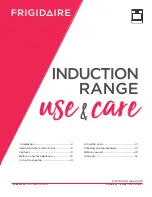
14
Examples of cooking power setting
(the values below are indicative)
1 to 2
Melting
Reheating
Sauces, butter, chocolate, gelatine
Dishes prepared beforehand
2 to 3
Simmering
Defrosting
Rice, pudding, sugar syrup
Dried vegetables, fish, frozen products
3 to 4
Steam
Vegetables, fish, meat
4 to 5
Water
Steamed potatoes, soups, pasta,
fresh vegetables
6 to 7
Medium cooking
Simmering
Meat, lever, eggs, sausages
Goulash, roulade, tripe
7 to 8
Cooking
Potatoes, fritters, wafers
9
Frying, roosting
Boiling water
Steaks, omelettes, fried dishes
Water
P
Frying, roosting
Boiling water
scallops, steaks
Boiling significant quantities of water
MAINTENANCE AND CLEANING
Switch-off the appliance before cleaning.
Do not clean the hob if the glass is too hot because they are risk of burn.
•
Remove light marks with a damp cloth with washing up liquid diluted in a little water. Then
rinse with cold water and dry the surface thoroughly.
•
Highly corrosive or abrasive detergents and cleaning equipment likely to cause scratches
must be absolutely avoided.
•
Do not ever use any steam-cleaner or pressure washer.
•
Do not use any object that may scratch the ceramic glass.
•
Ensure that the pan is dry and clean. Ensure that there are no grains of dust on your
ceramic hob or on the pan. Sliding rough saucepans will scratch the surface.
•
Spillages of sugar, jam, jelly, etc. must be removed immediately. You will thus prevent the
surface being damaged.
WHAT TO DO IN CASE OF A PROBLEM
The hob or the cooking zone doesn’t start-up :
•
The hob is badly connected on the electrical network.
•
The protection fuse cut-off.
•
The looking function is activated.
•
The sensitive keys are covered of grease or water.
•
An object is put on a key.
The control panel displays [ U ]:
•
There is no pan on the cooking zone.
•
The pan is not compatible with induction.
•
The bottom diameter of the pan is too small.
The control panel displays [ E ] :
•
Call the After-sales Service.






































